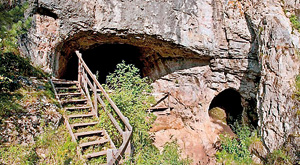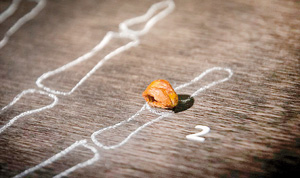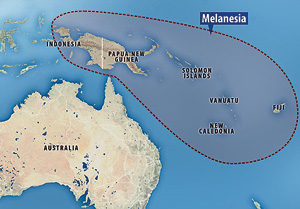Sunday Times 2
Did sex with extinct species help humans spread?
- DNA from mysterious Denisovans may have allowed Pacific Islanders to adapt to new environments
- Denisovans were a sister species to the Neanderthals; Denisovan DNA in modern day Melanesians
They are one of our closest extinct relatives yet we know almost nothing about them. Now a new study has shown that a mysterious species of early human, closely related to the Neanderthals, has left a lasting legacy on the genomes of islanders of the Pacific Ocean.

The Denisova Cave (entrance pictured) is the only location where the remains of Denisovans have been discovered. The cave was repeatedly used by them, Neanderthals and Homo sapiens
Scientists have discovered chunks of DNA from a prehistoric human species known as the Denisovans in the genomes of modern people living in Melanesia. It appears the homo sapien ancestors of the people living on this band of Pacific islands bred with some Denisovans as they travelled through Asia more than 48,000 years ago.
This illicit encounter may have been partly responsible for the ability of these early human migrants to spread as far across the Pacific and into Australia. The researchers, whose work is published in the journal Science, found 21 chunks of archaic DNA, at least three of which are from Denisovans.
These ancient fragments of DNA carry immunity genes that recognise viruses, while another increases blood glucose levels and another breaks down fats. These genes, the scientists say, may have helped modern humans adapt to new diseases, diets and climates as they moved into new territories.
Dr. Joshua Akey, a geneticist at the University of Washington who helped to lead the research, said: ‘Some of the sequences modern humans inherited from Neanderthals and Denisovans helped our ancestors survive and reproduce.’ The study provides growing evidence of the complex relationships our ancestors had with other species of early humans as they left Africa and spread out across Europe and Asia.
It suggests that modern humans interbred with Neanderthals at least five times and Denisovans at least once before the two species died out. Recent studies have suggested our own species, homo sapiens, may have first mated with Neanderthals as long as 100,000 years ago.
A study last week also provided evidence that Denisovans and Neanderthals themselves may have interbred around 440,000 years ago. In the latest study, researchers examined the DNA from 1,523 people from around the world, including 35 people from Papua New Guinea, which forms part of Melanesia.
They compared this to DNA that has been extracted from Neanderthal and Denisovan fossils. They found while the people from Melanesia appear to carry some Neanderthal DNA, they carry far less than those from Europe and other parts of Asia.
Instead between two and four per cent of their genomes were made up of Denisovan DNA, while other populations in the world had almost none.

Denisovans are known from just a single finger bone (pictured) and two molar teeth found in a cave in Russia
This suggests the ancestors of modern Melanesians split from the ancestors of Europeans and other Asians shortly after the first encounter between homo sapiens and Neanderthals. While Europeans and other Asians then interbred with Neanderthals a second time, the early Melanesians travelled across Asia where they encountered the Denisovans.
East Asians then broke away from Europeans and South Asians, picking up a third dose of Neanderthal DNA. DNA extracted from Neanderthal fossils hint at two further liasons with modern humans. However, Africans show no sign of either Neanderthal or Denisovan DNA in their genomes, which suggests their ancestors did not meet these two extinct species.
Benjamin Vernot, the first author on the new paper, said: ‘I think that people – and Neanderthals and Denisovans – liked to wander.’Studies like this can help us track where they wandered.
‘Different populations of people have slightly different levels of Neanderthal ancestry, which likely means that humans repeatedly ran into Neanderthals as they spread across Europe.’
Little is known about the Denisovans beyond the information that has been scraped together from genetic research.
The species are known from just one tiny fragment of finger bone and two molar teeth.

Scientists have used DNA extracted from these fossils to discover that they mated with the ancestors of the native inhabitants of Melanesia, leaving a lasting legacy in their genomes that can be seen today
They were discovered in the Denisova cave in the Altai mountains of Siberia, Russia.
Research has shown they are a sister species of Neanderthals but appear to have been a distinct species that perhaps evolved from another early human that migrated out of Africa 600,000 years ago.
Dr Andy Merriwether, a molecular anthropologist at Binghamton University, in New York, who was also involved in the study, said the spread of Denisovan DNA to Melanesia shows this enigmatic species has had a lasting impact.
He said: ‘I’m surprised that these Neanderthal and Denisovan genomes made it out to this remote place. ‘We know people have been there for at least 48,000 years because we find human remains that go back that far, but no one has ever been able to connect them to any other place.
‘When you compare most of their genome sequences, they don’t cluster with any other group. They’ve been there and been isolated for a very, very long time.’
The researchers also found large regions of modern human genomes where there is no archaic DNA. They said this strengthens the argument that there is something uniquely human contained within these.
Dr Akey said: ‘These are big, truly interesting regions.
‘It will be a long, hard slog to fully understand the genetic differences between humans, Denisovans and Neanderthals in these regions and the traits they influence.’
© Daily Mail, London

